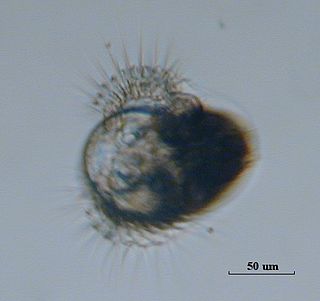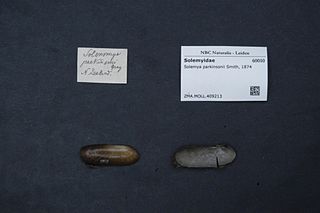
The shipworms are marine bivalve molluscs in the family Teredinidae: a group of saltwater clams with long, soft, naked bodies. They are notorious for boring into wood that is immersed in sea water, including such structures as wooden piers, docks and ships; they drill passages by means of a pair of very small shells borne at one end, with which they rasp their way through. Sometimes called "termites of the sea", they also are known as "Teredo worms" or simply Teredo, from the Greek τερηδώνteredōn, via Latin. Eventually biologists adopted the common name Teredo as the name for the best-known genus.

Bivalvia, in previous centuries referred to as the Lamellibranchiata and Pelecypoda, is a class of marine and freshwater molluscs that have laterally compressed bodies enclosed by a shell consisting of two hinged parts. Bivalves as a group have no head and they lack some usual molluscan organs like the radula and the odontophore. They include the clams, oysters, cockles, mussels, scallops, and numerous other families that live in saltwater, as well as a number of families that live in freshwater. The majority are filter feeders. The gills have evolved into ctenidia, specialised organs for feeding and breathing. Most bivalves bury themselves in sediment where they are relatively safe from predation. Others lie on the sea floor or attach themselves to rocks or other hard surfaces. Some bivalves, such as the scallops and file shells, can swim. The shipworms bore into wood, clay, or stone and live inside these substances.

A cold seep is an area of the ocean floor where hydrogen sulfide, methane and other hydrocarbon-rich fluid seepage occurs, often in the form of a brine pool. Cold does not mean that the temperature of the seepage is lower than that of the surrounding sea water. On the contrary, its temperature is often slightly higher. The "cold" is relative to the very warm conditions of a hydrothermal vent. Cold seeps constitute a biome supporting several endemic species.

A veliger is the planktonic larva of many kinds of sea snails and freshwater snails, as well as most bivalve molluscs (clams) and tusk shells.

Teredo navalis, commonly called the naval shipworm or turu, is a species of saltwater clam, a marine bivalve mollusc in the family Teredinidae. This species is the type species of the genus Teredo. Like other species in this family, this bivalve is called a shipworm, because it resembles a worm in general appearance, while at the anterior end it has a small shell with two valves which is adept at boring through wood.
Freshwater bivalves are one kind of freshwater mollusc, along with freshwater snails. They are bivalves which live in freshwater, as opposed to saltwater, the main habitat type for bivalves.

The Cryptodonta are a nearly-extinct subclass of the bivalves. It contains a single extant order, Solemyida, while the Praecardiida are known only from fossils.

Solemyidae is a family of saltwater clams, marine protobranch bivalve mollusks in the order Solemyida.
A mollusc valve is each articulating part of the shell of a mollusc. Each part is known as a valve or in the case of chitons, a "plate". Members of two classes of molluscs: the Bivalvia (clams) and the Polyplacophora (chitons) have valves.

Solemya parkinsonii is a species of saltwater clam, a marine bivalve mollusc in the family Solemyidae, the awning clams.
Solemya borealis, the boreal awning clam, is a species of saltwater clam, a marine bivalve mollusc in the family Solemyidae the awning clams. This species is found along the northeastern coast of North America, from Nova Scotia to Connecticut.
Solemya occidentalis, the West Indian awning clam, is a species of marine bivalve mollusc in the family Solemyidae. This species is found in the western Atlantic Ocean from Florida to the West Indies.

Solemya velum, the Atlantic awning clam, is a species of marine bivalve mollusc in the family Solemyidae, the awning clams. This species is found along the eastern coast of North America, from Nova Scotia to Florida.

Codakia orbicularis, or the tiger lucine, is a species of bivalve mollusc in the family Lucinidae. It can be found along the Atlantic coast of North America, ranging from Florida to the West Indies.

Protobranchia is a subclass of bivalve molluscs. It contains the extant orders Nuculanida, Nuculida, and Solemyida.

Mulinia lateralis, the dwarf surf clam or coot clam, is a species of small saltwater clam, a bivalve mollusc in the family Mactridae. It occurs in the western Atlantic Ocean and the Caribbean Sea.
Enigmonia is a genus of saltwater clams, a marine bivalve mollusc in the family Anomiidae, the jingle shells. Enigmonia aenigmatica, the mangrove jingle shell clam, is the only species in this monotypic genus. It is found living on mangroves in the Indo-Pacific Ocean.

A prodissoconch is an embryonic or larval shell which is present in the larva of a bivalve mollusk. The prodissoconch is often but not always smooth, and has no growth lines. It is sometimes still present and visible in the adult shell, if there has been no erosion of the shell in that area.

Solemya elarraichensis is a species of marine bivalve mollusc in the family Solemyidae. It is endemic to the deep-water mud volcano slopes in the Gulf of Cadiz in the eastern Atlantic Ocean.












